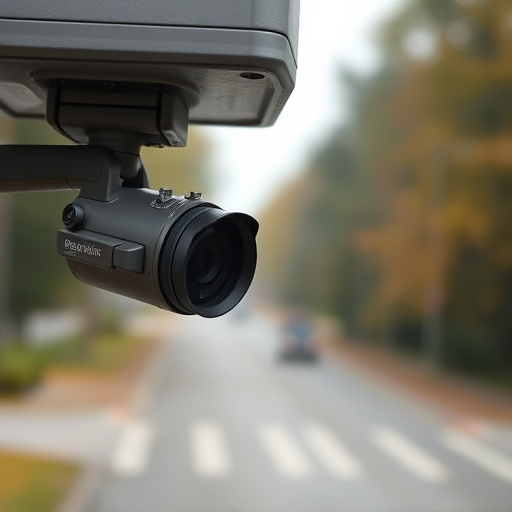Understanding glint, or light reflection from smooth surfaces, is crucial when hiding nanny cams for effective and unobtrusive surveillance. Strategically place cameras away from direct lighting and reflective surfaces like windows or mirrors, using concealment methods like corners, behind furniture, or natural cover outdoors. This minimizes unwanted reflections that can compromise privacy and security in low-light conditions, ensuring clear footage while respecting individuals' privacy through transparent practices and obtaining consent.
In the dark of night, hidden cameras offer peace of mind for many homeowners. However, effective night vision surveillance requires understanding and mitigating lens glint—the reflective glow that can reveal camera locations. This guide delves into cutting-edge methods for detecting glint, focusing on optimal camera placement and advanced analysis techniques. We also explore the ethical implications of using ‘nanny cams,’ emphasizing responsible practices when considering where to hide cameras in your home or property.
- Understanding Glint in Night Vision
- Camera Placement for Optimal Concealment
- Analyzing Lens Reflections at Night
- Ethical Considerations of Nanny Cam Tactics
Understanding Glint in Night Vision
Glint, in the context of night vision photography, refers to the intense reflection of light from smooth surfaces, such as glass or water, which can obscure details and ruin an image. This phenomenon is particularly challenging during low-light conditions when camera sensors are more sensitive. In the case of hidden surveillance cameras, like nanny cams, understanding glint is crucial for effective placement.
When setting up a nanny cam, consider the environment where it will be placed. Surfaces like windows, mirrors, or shiny metal objects nearby can cause glint and reflect light directly into the lens. To combat this, strategic placement is key—look for areas with minimal direct lighting or surfaces that diffuse light, and always remember to hide the camera where it won’t be easily visible, avoiding obvious places where a curious eye might find it.
Camera Placement for Optimal Concealment
When it comes to installing nanny cams or any surveillance device, strategic camera placement is key for optimal concealment. The goal is to mount the lens in a way that it captures clear footage without drawing attention to itself. This often involves positioning the camera where it can see the desired area without being readily visible. Common spots include corners, behind furniture, or even disguised as everyday objects like books or clocks.
For indoor spaces, consider places like above doors, in hallways, or behind curtains. Outdoors, trees, bushes, or other landscaping features can provide natural cover. The key is to ensure the lens is aligned correctly, with a clear view of the target area, while remaining hidden from plain sight. This careful placement helps maintain the integrity of the surveillance system and ensures effective monitoring without unnecessary alerts or suspicions.
Analyzing Lens Reflections at Night
At night, with reduced lighting conditions, camera lenses can inadvertently capture unwanted reflections, known as glints, which can compromise the privacy and security measures in place. To effectively detect and mitigate these glints, particularly when considering where to hide nanny cams or other surveillance devices, a methodical approach is required. By analyzing lens reflections during nighttime hours, individuals responsible for setting up such cameras can identify potential sources of glare and take necessary precautions.
This process involves meticulously scanning the surroundings for any shiny surfaces that might reflect light directly into the camera lens. Common culprits include windows, mirrors, or even reflective coatings on modern glass structures. By understanding these reflections and their impact, one can strategically position the camera to minimize direct line-of-sight with such surfaces, ensuring the footage remains clear and secure.
Ethical Considerations of Nanny Cam Tactics
While discussing methods for camera lens glint detection at night, it’s crucial to address the ethical considerations surrounding the use of “nanny cams.” The placement of hidden cameras in homes or care settings raises privacy concerns, particularly when used without explicit consent. Even with legal authorization, where to hide nanny cams becomes a delicate issue, as it invades personal spaces and can foster an environment of mistrust.
Professionals in this field must adhere to strict ethical guidelines, prioritizing respect for individuals’ privacy and autonomy. It’s essential to strike a balance between ensuring safety and monitoring through transparent practices, obtaining necessary permissions, and providing clear communication about surveillance systems in place. This approach helps maintain trust while still enabling effective monitoring during the night.
Detecting glints from camera lenses in night vision scenarios is a critical step in deploying hidden surveillance, like nanny cams, ethically and effectively. By understanding glint behavior, strategically placing cameras for optimal concealment, and carefully analyzing lens reflections under low-light conditions, you can capture clear footage while minimizing the risk of detection. Remember, responsible use of such tactics requires considering privacy ethics and local laws regarding hidden surveillance devices, ensuring where to hide nanny cams responsibly and discreetly.
